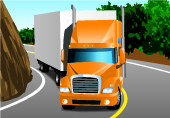Steering (forward) and off-track
The rear wheels of the vehicle do not pivot and therefore will not follow the same path as the front wheels. The greater the distance (wheel base) between the front wheels and the rear wheels of the vehicle, the greater the amount of “off-track.” The off-track path has a shorter radius than the path of the front wheels.
On the open highway, you must lead your turning arc of the front wheels according to the sharpness of the curve and the amount of off-track of your vehicle (Diagrams 2-7 and 2-8). A curve to the right requires keeping the front wheels close to the left side of the lane to prevent dropping the rear wheels off the pavement. A curve to the left requires keeping the front wheels close to the right edge of the pavement to prevent the rear wheels from crossing into the other traffic lane.

Illustration 2-7

Illustration 2-8
A combination vehicle such as a semi-trailer unit has an off-track of the rear wheels of the tractor unit, and a greater off-track again of the rear wheels of a semi.
The combination unit of a truck-tractor and semi-trailer has different turning characteristics. These units have a turning radius and off-track pattern within each unit, but the amount of off-track depends upon the length of the combination and the wheel base of the units.
If possible, do not change lanes to turn. If you must use portions of an alternate lane to make a steep turn, it is up to you to ensure that it is done safely and without interfering with traffic.